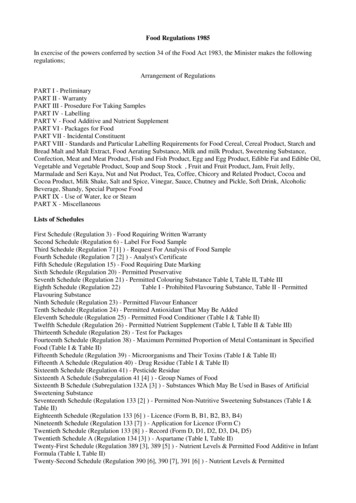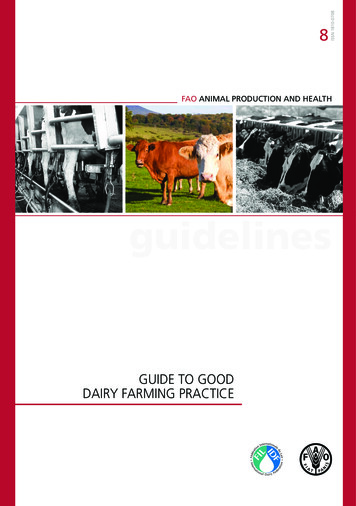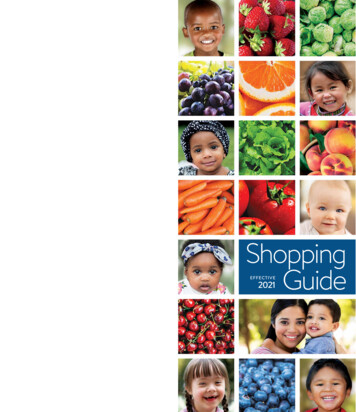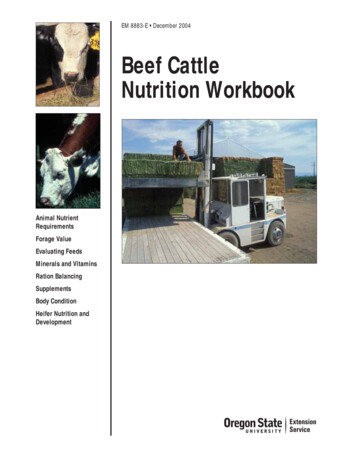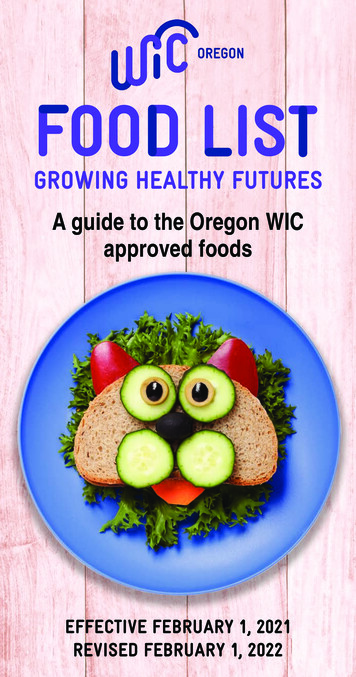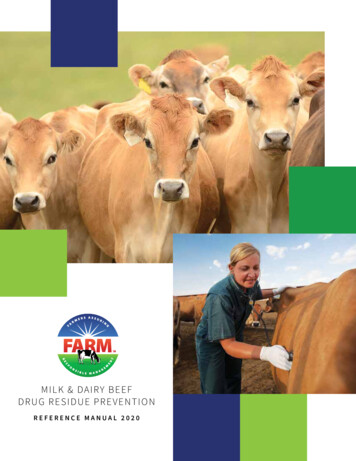
Transcription
M I LK & DAIR Y B E E FD RU G RE S I DU E PR E VE NTIONREFERENCE MANUAL 2020
National Milk Producers Federation (NMPF) does not endorse any of the veterinary drugs ortests identified on the lists in this manual. The lists of veterinary drugs and tests are providedonly to inform producers and veterinarians what products may be available, and theproducer and veterinarian are responsible for determining whether to use any of theveterinary drugs or tests. All information regarding the veterinary drugs or tests was obtainedfrom the products’ manufacturers or sponsors, and NMPF has made no further attempt tovalidate or corroborate any of that information. NMPF urges producers to consult with theirveterinarians before using any veterinary drug or test, including any of the products identified on the lists in this manual. In the event that there might be any injury, damage, loss orpenalty that results from the use of these products, neither the manufacturer of the productor the producer using the product shall be responsible. NMPF is not responsible for, and shallhave no liability for, any injury, damage, loss or penalty. 2020 National Milk Producers FederationThis manual is not a legal document and is intended for educational purposes only.Dairy farmers are individually responsible for determining and complying with allrequirements of local, state and federal laws and regulations regarding animal care.2
Table of ContentsChapter 1: Introduction1Chapter 2: Residue Prevention Best Practices3Chapter 3: Record Keeping andHerd Health Protocols7Chapter 4: Drug Administration10Chapter 5: Culling of Animals14Chapter 6: Residue Testing17Chapter 7: Drug Classes22Chapter 8: Approved Drugs and Screening Tests27Glossary66Contact Information683
4
ForewordThe goal of our nation’s dairy farmers is to produce the best tasting and most wholesome milkpossible. Our consumers demand the best from us and our goal, through continuous improvement,is to meet their needs and exceed their expectations every day.Day in and day out, our dairy farmers provide the best in animal husbandry. As part of continuousimprovement, we evaluate our best management practices and disease prevention protocols to keepour animals healthy and comfortable. There are occasions when animals may get sick and need antimicrobial therapy to overcome a specific disease challenge. As dairy producers, we strategically andprudently use antimicrobial therapies to help an individual animal that has been threatened with adisease. We take this responsibility of prudent antimicrobial use seriously and take many precautionswith our antibiotic-treated animals to ensure that their milk or meat does not enter the food supply.The avoidance of milk and meat residues takes an on-farm team effort that begins with the VCPR – theVeterinarian-Client-Patient Relationship. Dairy farm owners, managers and herdsman work with theirveterinarians to develop treatment protocols that ensure that antimicrobials are used correctly. Oncea decision is made to use antimicrobials, protocols are in place to guide employees on the safe way tohandle the animal to prevent an inadvertent milk or meat residue from occurring. Proper identificationof treated animals and accurate recording of drug use are essential to prevent residues.For 30 years, each revision of the Milk & Dairy Beef Drug Residue Prevention Reference Manual hasserved as the U.S. dairy industry’s commitment to antimicrobial stewardship – the prudent andresponsible use of antibiotics and other drugs in dairy animals. This year’s revised manual is a quickresource to review those drugs approved for dairy animals and can also be used as an educationaltool and resource for farm managers as they develop on-farm best management practices. I encourageall dairy farmers to sit down with their veterinarians and employees to review this manual as you willfind the information useful, practical and easily applied to your individual farms.Sincerely,Karen Jordan, DVMDairy Producer ChairNMPF Animal Health and Well-Being Committee5
6
01IntroductionThe U.S. dairy industry is committed to producing the highest quality, safe, abundant and affordable milkand dairy beef. Healthy animals help make for safe food, and disease prevention is the key to keepingcows healthy. When dairy animals get sick and treatment is necessary, producers and veterinariansutilize antibiotics and other drugs prudently. Antimicrobials must be used appropriately under veterinaryguidance to prevent residues from occurring in milk and dairy beef. The marketing of milk or dairy beefwith drug residues, even unintentionally, is illegal and can result in financial and criminal penalties.Antimicrobial StewardshipAntimicrobial stewardship goes beyond an individual dairy farmer’s actions. It extends across all livestockproduction, and includes use of antimicrobials in companion animals and humans, even extending tosome types of crop production systems. Misuse and overuse of antimicrobials is one of the world’s mostpressing public health concerns. Infectious organisms adapt to antimicrobials designed to kill them, making the drugs less effective. The Food and Drug Administration Center for Veterinary Medicine (FDA CVM)has committed to antimicrobial stewardship for use in animals through principles and key initiatives.According to the American Veterinary Medical Association (AVMA): "Antimicrobial stewardship cannot beranked by intent of use for prevention, control or treatment. Strategic uses of antimicrobials for the purposes of prevention, control and treatment of disease may each meet the requirements of antimicrobialstewardship. Stewardship is better defined by decisions that influence the need for antimicrobial therapyin the first place and that maintain the effectiveness of antimicrobials when they are used."Factors include the following: Systems of husbandry that reduce the risk of diseaseCareful diagnostic evaluationGood decision-making to use or not use antimicrobialsPrudent choice of drugs, dosage and durationRecords indicating appropriate follow-up and re-evaluationC ha pter 1 : In t rod u cti o n1
AVMA Definitions of Antimicrobial Use for Treatment,Control and PreventionAVMA believes antimicrobial stewardship can be achieved whether the intent is prevention, control ortreatment, and attempts to prioritize antimicrobial stewardship by therapeutic purpose are misguided.Stewardship is better demonstrated by the clinical rationale for antimicrobial therapy. We provide thefollowing definitions for treatment, prevention and control in the context of antimicrobial use inindividual animals or populations of animals.Antimicrobial prevention of disease(Synonym: prophylaxis)1. Prevention is the administration of an antimicrobial to an individual animal tomitigate the risk for acquiring disease or infection that is anticipated based on history,clinical judgment or epidemiological knowledge.2. On a population basis, prevention is the administration of an antimicrobial to a groupof animals, none of which have evidence of disease or infection, when transmissionof existing undiagnosed infections, or the introduction of pathogens, is anticipatedbased on history, clinical judgment or epidemiological knowledge.Antimicrobial control of disease(Synonym: metaphylaxis)1. Control is the administration of an antimicrobial to an individual animal with asubclinical infection to reduce the risk of the infection becoming clinically apparent,spreading to other tissues or organs or being transmitted to other individuals.2. On a population basis, control is the use of antimicrobials to reduce the incidenceof infectious disease in a group of animals that already has some individuals withevidence of infectious disease or evidence of infection.Antimicrobial treatment of disease:1. Treatment is the administration of an antimicrobial as a remedy for an individualanimal with evidence of infectious disease.2. On a population basis, treatment is the administration of an antimicrobial to thoseanimals within the group with evidence of infectious disease.2C h a pte r 1 : Introduct i o n
02Residue Prevention Best PracticesCauses of Antibiotic Residuesin Milk and MeatDrug residues can be avoided with implementationof a well-planned drug use program. Reasons givenfor milk and meat residues result from many onfarm situations. These include, but are not limitedto, the following: Not working under a valid Veterinarian-ClientPatient Relationship Failure to keep accurate and adequate drug userecords Not following the manufacturer or veterinarianprescribed label directions for correct treatmentfor the appropriate withdrawal time Not following veterinarian’s recommendationwhen using any drug Poor identification of all cattle including bullcalves Accidentally milking a treated cow into the bulktank or not diverting from the bulk tank Long-term residue following treatment as a calf Use of medicated milk replacers in calves thatmay be sold for human consumption The use of prohibited drugs or aminoglycosides(e.g. , gentamicin) in cattle. The USDA and FDA arestill detecting gentamicin residues in cattle. The use of compounded medications in cattle,including the intentional use of multiple drugsin a single animal, including both simultaneousand consecutive dosing. Animal liver and kidneyfunction, particularly in unhealthy animals wheredrug metabolism may be compromised, maynot be able to keep up with multiple circulatingdrugs potentially resulting in poorly defined andsignificantly extended drug withholding times. The practice of spraying hairy heel warts withantibiotic sprays in the milking parlor duringmilk harvest is a potential source for antibioticcontamination of milk. This practice should beavoided. The use of sulfonamide (e.g. sulfadimethoxine)products extra-label in lactating dairy cows.C ha pter 2 : Res idue P re ven t ion Best P racti ce s3
Examples of Products and Risk Factors for ResiduesCeftiofur(also known as Ceftiflex ,Excede , Excenel ,Naxcel , Spectramast LC ,Spectramast DC)Enrofloxacin(Baytril 100 )Florfenicol(Nuflor ) Flunixin(also known as Banamine ,Flu-NixTM, Flunixinmeglumine**, ycline Failure to keep accurate records and note the exact product given (Excede versus Excenel).Using the withholding time for one product when using another.The withholding times for each product and formulation are different.Using the drug in an unapproved route of administration. Excede is labeled to be given atthe base of the ear only. Spectramast is the only ceftiofur product labeled for intramammaryadministration. Using these drugs in a route of administration not listed on the label is prohibited. All products have a preslaughter withdrawal period, please consult the manufacturer’s label forapproved withdrawal times. Only labeled for non-lactating dairy animals 20 months of age or less and beef animals forpneumonia.* Extra-label use in food animals is prohibited. Not approved for dairy cattle over 20 months of age. Sustained release has a longer withdrawal time. No tolerance level for dairy cattle. These drugs are only approved for intravenous administration. Using another administration route (e.g. IM or SQ) results in extended withdrawal times, wellbeyond the labeled withholding time. Use of gentamicin is discouraged by AVMA, AABP and AVC because of extremely long retention inthe kidneys, which results in very extended withdrawal times use. Use of gentamicin in lactating dairy cows for intramammary use is not recommended. FARAD recommends not less than a TWO-YEAR withdrawal period and, therefore, the use of thisdrug should not be considered. Feeding medicated milk replacer to calves to be processed for slaughter. Not following withdrawal time on the bag. Extra-label use of oral neomycin products. Use at non-labeled doses can only be done by prescription and with the oversight of theprescribing veterinarian. Increasing the dose without using an extended withdrawal period. Increasing the frequency or duration of administration without using an extended withdrawalperiod. Using the drug in a route of administration not approved, such as intramammary or subcutaneous. Giving more than 10 CC/injection site (as per label instructions). Using any sulfonamide product not labeled for lactating dairy cows is illegal. Using a higher dose or frequency of administration will result in extended withdrawal times. This drug is only approved for the treatment of respiratory disease. Application for treatment ofmastitis is illegal. Inadvertently administering a sustained release product when intending to use a daily useproduct. Single-site, large-volume injection through non-intravenous route. Extra-label use such as uterine infusion to treat an infected post-partum uterus.*Bovine respiratory disease (BRD); consult product label for actual indications.**Due to the high risk of a violative residue, flunixin must only be used intravenously and not be given by either subcutaneousor intramuscular routes of administration.4C h a pte r 2 : Resi due Pre vent i o n Best Pra ct i ces
Minimizing Drug RiskSteps to Prevent Drug ResiduesDairy producers realize the importance of eliminating the possibilities of having drug residues in milk anddairy beef. Producers can take the following steps to mitigate or lessen the chances of antibiotic residues:1. Establish a valid Veterinarian-Client-PatientRelationship (VCPR) to ensure proper diagnosis and treatment of disease. The agreementshould be reviewed at least annually witha Veterinarian of Record (VOR) who makesroutine visits to the farm.2. Keep accurate records of antibiotic use andidentify all treated animals, including treatment protocols.3. Implement a preventive Herd Health Plan toreduce the incidence of disease.9. Use drug residue screening tests specific forthe drug utilized before marketing milk and/or meat from treated animals. Ensure detailedunderstanding of the test being used. Themajority of tests are developed for use in bulkmilk and are not designed for application inindividual animals.10. If in doubt about residue status, do notmarket milk and/or cull treated animals andseek input from your veterinarian and/or yourmilk handler.4. Maintain milk quality and implement aneffective mastitis management program toreduce the need for antibiotics, includingprotocol development and review.5. Implement employee training and awarenessof proper animal drug use.6. Use drugs approved for specific diseaseindications according to labeled directionsand withdrawal periods. If extra label drug useis indicated by a veterinarian’s prescription,that veterinarian must establish anddocument appropriate withdrawal periods.7. Do not use drugs that are not specificallyapproved for use in a specific class of cattle(milking, dry or growing animals).8. Segregate and milk treated animals after, orin a separate facility from, all non-treatedanimals to ensure that milk is not accidentallycommingled.C ha pter 2 : Res idue P re ven t ion Best P racti ce s5
Food Animal Residue Avoidance Databank (FARAD)FARAD is a university-based national program that serves as the primary source forscientifically-based recommendations regarding safe withdrawal intervals of drugs andchemicals in food-producing animals. As such, FARAD is a key resource for protection of ournation's food supply, including meat, milk and eggs, against accidental contamination ofanimal-derived foods with violative residues of drugs, pesticides or other agents that couldcompromise food safety.Modern animal agriculture relies heavily on the use of therapeutic drugs, pesticides andother agents that improve overall animal health and promote safe, efficient and humaneproduction practices. Through the assimilation of a comprehensive drug database and theuse of state-of-the-art pharmacokinetic modeling, FARAD scientists determine appropriatewithdrawal periods for a wide array of chemical entities and provide this information toveterinarians, extension specialists and livestock producers through a toll-free call center aswell as a publicly-accessible website (FARMWeb).In addition, FARAD provides rapid response assistance regarding extra-label use of drugsin animal agriculture, and during food contamination emergencies which might arise fromaccidental exposure to environmental toxins, particularly pesticides, or intentional efforts tocontaminate the food supply. Finally, FARAD provides assistance in trade matters related toforeign drug approvals and trains future veterinarians in the principles of residue avoidance.FARAD is a USDA-funded university-based consortium that is overseen and operatedby faculty and staff within the Colleges of Veterinary Medicine at the University ofCalifornia-Davis, the University of Florida, Kansas State University, North Carolina StateUniversity and Virginia-Maryland College of Veterinary Medicine.Visit WWW.FARAD.ORG for more information.6C h a pte r 2 : Resi due Pre vent i o n Best Pra ct i ces
03Record Keeping and Herd Health ProtocolsVeterinarians must maintain written (or electronic) records for all animals treated for at least two years(or as otherwise mandated by federal or state law) to document that the drugs were supplied to clientsin line with federal and state rules and policies. Dairy farmers should have a records system that is easilyaccessible to everyone who works with the animals. Records should be permanent and maintained inwritten or computer records for at least two years, so veterinarians have a history to which they can referto prescribe effective therapy and to serve as information in case of regulatory follow-up. The producerneeds to show how all drugs purchased were used or disposed. The treatment record should contain thefollowing basic information: Date of treatmentAnimal treated identificationName of treatment usedDisease/condition being treatedDosage administeredRoute of administrationDuration of the treatmentSpecified withdrawal times for milk and meat to ensure food safetyCode of Federal Regulations 21 CFR 530.5. Food and Drug Administration. April 1, docs/cfcfr/CFRSearch.cfm?fr 530.5ReferencesCode of Federal Regulations 21 CFR 530.5. Food and Drug Administration. April 1, docs/cfcfr/CFRSearch.cfm?fr 530.5C ha pter 3 : Record K eepin g a n d H erd H ea l t h P roto co l s7
8-STEP PLAN for Keeping RecordsStep 1: Recommended or Approved Drug ListEarly in your discussion with your herd health veterinarian you need to make a narrow list of drugs to beused on your dairy. The intent is to reduce the scope of drugs used. A short list will permit you to focus yourknowledge and will help to prevent a violation of antibiotic residue laws.Step 2: Animal Treatment PlanIn order to prevent, control or treat disease or infection, while promoting public health and food safetythrough residue prevention, it is important to be consistent. The second step is for you to establish atreatment plan for your herd health practices. The treatment plan should be written in consultationwith your herd health veterinarian.Step 3: Beginning InventoryYou and your herd health veterinarian should properly discard all expired drugs, all drugs no longer utilized aspart of a treatment plan and all drugs not on your approved drug list. (Step 1) Conduct an inventory of drugsand other appropriate information annually.Step 4: Record Medicated Feed PurchasesAntibiotic residues can occur from feeding practices as well as injections or other medical treatments. Be sureto clean feed equipment between batches. Carefully avoid disposing of leftover feed from feeder calves, hogs,etc., to lactating dairy cattle. Be aware that feeding medicated milk replacer or waste milk to calves intendedfor sale can be a cause of violative tissue residues.Step 5: Record of Drug PurchasesMost successful dairy producers will record every purchase of drugs the day they are purchased. The FDArequires a paper trail of all drugs used on your dairy, so it is important to record the purchase of drugs promptly.Step 6: Daily Treatment RecordIf a drug is used, keep track of it in the Daily Treatment Record. In hindsight, dairy producers who havemarketed milk or dairy beef with violative residues state that keeping better treatment records andproperly identifying treated cows could have prevented the residue. Develop good habits to properlymanage all medications.Step 7: Monthly Economic ComparisonWhen do you “cull” a market cow from your herd? Every month you should review the investment you aremaking in each cow in the milking string. Compare your expenses by using the Daily Treatment Records.Step 8: DisposalPeriodic review of drugs in storage will mean you occasionally throw away drugs that have expired. Byrecording your daily animal treatments and any discarded drugs, you create a paper trail of what hashappened to all drugs purchased. This eight-step drug management system may prevent you fromincurring a costly and embarrassing antibiotic accident!8C h a pte r 3 : Record Keepi ng a nd Herd Hea lt h P rotocol s
Herd Health PlanThe dairy industry’s commitment to antibioticstewardship begins on the farm with coordinatedanimal health and care programs, including aHerd Health Plan developed in consultation withthe Veterinarian of Record (VOR) and reviewedannually. Even with the best prevention programs,animals can become sick or injured, and prudentand responsible use of antimicrobials (includingantibiotics) under veterinary supervision maybe necessary to improve the health outcomeof the animal.An effective written Herd Health Planfocuses on: Disease and Injury- Prevention- Rapid diagnosis- Necessary treatment Animal Caretakers- Training- Defined responsibilities Annual Review with the Veterinarian of Record- Timely updatesRecord Keeping, Protocol andAntibiotic Stewardship TemplatesPlease visit www.nationaldairyfarm.com forfree record keeping and drug managementrecord forms: Veterinarian-Client-Patient Relationship(VCPR) Form Recommended or Approved Drug List Sample Animal Treatment Plan Beginning Drug Inventory Record of Drug Purchases Daily Treatment Record Drug Disposal Record Considerations for Culling Poster Draft Herd Health PlanFood Armor FoundationThe Food Armor Foundation is anon-profit 501(c)3 organization witha passionate team of food industryprofessionals ranging from producersand veterinarians to packers, processorsand food marketers. The beginningsof the program go back to 2010 inWisconsin where, through educationand a grass-roots approach, Food Armorwas able to reduce an unacceptably highincidence of tissue residues to near zerolevels, while gaining respect across theveterinary community, maintaining abroad stakeholder perspective (includingveterinarians) and building years ofexperience in translating guidelinesinto education. Food Armor strives toprovide a solid educational foundationfor every food animal veterinariansigning a VCPR for a farming operationand is working together with industryleaders to strengthen the meaning of theVCPR. Food Armor’s online educationallearning system is designed to provideevery veterinarian with the knowledgeand skills necessary to build a robustantimicrobial stewardship program,one farm at a time.C ha pter 3 : Record K eepin g a n d H erd H ea l t h P roto co l s9
04Drug AdministrationSites and TechniquesInjections should be given in the neck to prevent costly damage to economically important cuts of beef.This is particularly important when administering intramuscular (IM) products. It also makes it easier forpackers to identify lesions at the plant level, so they do not inadvertently end up on a consumer’s plate.To lessen injection site defects, the preferred site for all injections has now been reduced to the smallerinjection area of the neck region (Fig. 2). In the 2016 National Beef Quality Audit injection site lesionsfound in the rounds of dairy animals had fallen to 15 percent, compared to 60 percent in 1998.Several animal health products are now approved for injection into the ear of cattle. This location isexcellent from a quality assurance perspective as ears are removed at harvest and do not enter the foodchain. Certain antibiotics are approved for the ear injection site. The exact location on the ear dependson the product. However, the route approved for lactating dairy cows is the base of the ear. The ear mustbe very clean, and care must be taken to avoid blood vessels. Read product labels carefully. An exampleof the base of ear (BOE) injection technique can be found at: ng-administration.aspx.Types ofInjections10C h a pte r 4 : Dru g Adm i ni st rat i onIM – Intramuscular (Administered in the muscle)IMM – Intermammary (Administered in the udder anddoes not use needle)IV – Intravenous (Administered in the vein)SQ – Subcutaneous (Administered under the skin)
Whenever possible, choose products formulated and labeled for injectionunder the skin (subcutaneous/SQ) rather than intramuscular (IM).Figure 1: SQ Injection“Tent” Technique. The “tent”Figure 2: IM Injection Zone. To lessen injection sitedefects, the preferred injection site has been reduced to thesmaller (dark red) injection area shown above — particularlywith IM products. This has become necessary to ensure thequality of new value-added products from the chuck. Even inthe absence of blemishes, case-ready packaging processescan cause discoloration of meat near an injection site.techniqueensures thatproductPrevious ZoneNew theInjectionZoneis truly being administered in thesubcutaneous region.Previous ZoneNew Injection ZoneROUTE OF ADMINISTRATION VIA NEEDLEINJECTABLEVISCOSITYSQIVIM(1/2 - 3/4" Needle)(1 1/2" Needle)(1-1 1/2" Needle)Cattle Weight lbs.Cattle Weight lbs.Cattle Weight lbs. 300300 to700 700 300300 to700 700 300300 to700 auge16gauge16gauge(Example: Saline)(Example: Tetracycline)Select the needle to fit the cattle size (the smallest practical size without bending)Primary considerations in needle selection are: Route of administration Size of the animal Location or site of the injectionSecondary considerations include: Viscosity of the fluid (how thick and tenacious the fluid is) Volume injectedC ha pter 4 : Dr ug A dm in istrati o n11
Drug Administration Best PracticesCleaning Syringes and NeedlesThe use of disposable equipment is recommendedand preferred. If reusable syringes, needles andother injection equipment are used, they shouldbe heat-sterilized by boiling. If any disinfectantsare used — including alcohol — they must bethoroughly rinsed from equipment because theyneutralize vaccines and chemically react withsome antibiotics.Syringes should be thoroughly rinsed with sterilewater before use. Sterile water can be purchased.Please note that distilled water is not sterilewater. Consult your veterinarian before sterilizingequipment to ensure proper techniques. Impropersterilization can reduce the effectiveness of futureinjections and result in infection at the injectionsite. Do not contaminate modified live virusproducts with disinfectants as effectivenesswill be decreased or even eliminated.Needle Quality Control and SafetySingle-use needles are preferred to helpprevent the spread of blood-borne diseases like12C h a pte r 4 : Dru g Adm i ni st rat i onLeukosis. This virus is a leading cause of carcasscondemnation in slaughter facilities. At a minimum,be sure to change needles at a maximum of every10 head to prevent using a dull needle. Changeneedles immediately if the needle bends. Do notstraighten it or use it again. Obtain a new needleif the needle in use becomes contaminated withfeces or an irritating chemical.A broken needle is an emergency and time is of theessence. Broken needles migrate in tissue. If notimmediately handled, they will be impossible tofind — requiring the animal to be destroyed. Underno circumstances should animals with brokenneedles be sold or sent to a packer. If necessary,contact your veterinarian to assist in determininghow animals will be handled should a needle breakin the neck muscle.Needle Storage and DisposalStore used needles in a protected area using thesedisposal guidelines: Place in puncture resistant container with secure lid Place container in rigid containerlined with plastic Dispose of as solid waste
When treating animals with any producttake the following precautions: Read both the product label and insertand consult your veterinarian beforeadministering drugs. Be sure the injection site is clean and use asterile needle for all injections. Use the labeled dosage and method ofadministration least likely to create a drug residue. Discard milk from all four quarters even whentreating only one quarter with an IMM infusion. Milk treated cows last or use a segregated facility(divert milk from bulk tank or saleable milk). Thoroughly wash all equipment (inflations,hoses, weigh jars, etc.) that has come in contactwith milk from treated cows. Make certain that any procedure used to divertmilk from treated cows cannot accidentally sendcontaminated milk into the pipeline. Keep medicated feeds separated fromnon-medicated feeds. Ensure that calves fed antibiotic waste milk ormedicated milk replacer are not sent to sale orslaughter until withdrawal times are met. Train employees on proper injectionsite selection. Clean transfer needles regularly to avoidcontamination. Do not go back into the vaccine bottle with aneedle once it has been used for anything else. When vaccinating groups, changeneedles frequently. When using killed vaccines, keep a saucer orsp
guidance to prevent residues from occurring in milk and dairy beef. The marketing of milk or dairy beef with drug residues, even unintentionally, is illegal and can result in financial and criminal penalties. Antimicrobial Stewardship Antimicrobial stewardship goes beyond an individual dairy farmer's actions. It extends across all livestock
